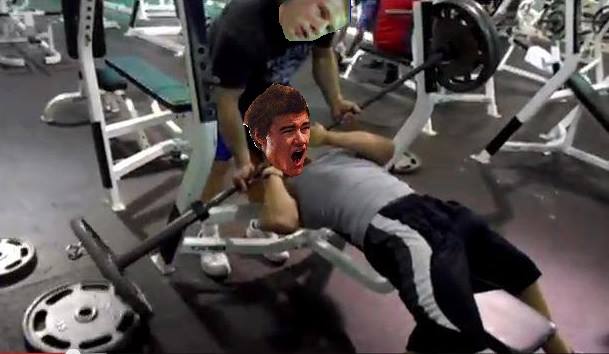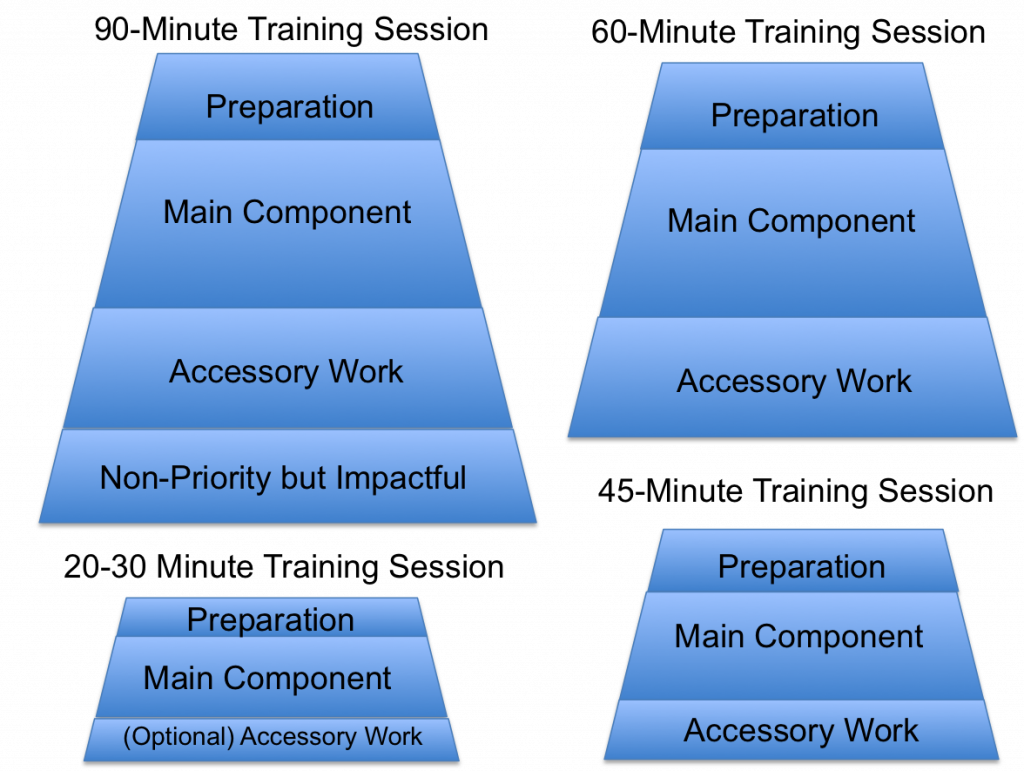5 Goals, 5 Strategies
“Most of us spend too much time on what is urgent and not enough time on what is important.” ― Stephen R. Covey
“The Principle of Priority states (a) you must know the difference between what is urgent and what is important, and (b) you must do what’s important first.” ― Steven Pressfield, The War of Art: Break Through the Blocks & Win Your Inner Creative Battles
There’s a lot of different ways to accomplish something in fitness and exercise, and in many cases those goals can be at odds with each other. If you’re looking to get progressively stronger and build muscle, it’s tough to do while in a caloric deficit, and some would even say impossible, so looking to lose weight and gain muscle simultaneously can be incredibly challenging from not just a dietary perspective, but from a training program design as well. If you’re looking to run an Ironman Triathlon, and simultaneously train for a bikini competition, it’s very much a set of polarizing goals which will likely be tough to do well in either, let alone both.
This shouldn’t come across as anything new. Competing demands are tough to balance simultaneously, regardless of whether they’re in the world of fitness or anything else. It’s tough to remodel your house and increase your savings for retirement at the same time and come out ahead in both when it’s all said and done.
I think this is one of the biggest issues with ineffective programs. They tend to use too much of competing concepts and principles or variables that don’t necessarily speak to each other in terms of benefitting the individual for the goals they’re trying to achieve. It’s great to use postural training tools when important, but if someone is looking to drop 50 pounds of bodyfat and has no pain issues, it’s probably not the best use of their time. Likewise, while a powerlifter can benefit from breathing modalities, it shouldn’t replace the heart of their training in the 3 lifts.
A challenge a lot of people have when writing a program, whether they’re a trainer or someone who works out and wants to train themselves, is knowing where to start. There’s so many options out there and they all sound good.
We can overcome the paralysis by choice options with a couple of very simple and direct questions:
- What’s your actual goal?
- If you only had 10 minutes to do something to positively affect your goal, what would that be?
- In decending order of importance, what else will help you reach that goal?
So in order to simplify the process, here’s the answers to these questions.
- What is your actual goal? – Focus on only things that help you achieve this, and nothing else.
- If you only had 10 minutes to do something to positively affect your goal, what would that be? – This cuts out the clutter and let’s you know what is most important. Do that first in your workouts.
- In decending order of importance, what else will help you reach that goal? – This fills in the rest of the workout for you, and let’s you know what you can skip or include based on time.
Let’s look at question 2. What’s most important to help you reach that goal? Starting a workout with this vitally important elements gives you a couple of key benefits. First, you’re freshest at the beginning of your workout, so fatigue isn’t affecting the technique or intensity you can apply to the exercise like it would if you did it last.
I remember when I was in high school and decided to switch the order of my chest training day around and did bench press last instead of first. Now while the idea of the heaviest and most likely life-threatening exercise when you’re maximally fatigued sounds good on paper, you can guess what the results were.

I wound up getting pinned under my warm up weight, and an old guy with too-short shorts and smelling of cheese and stale nachos helped peel the bar off my chest. It was a valuable lesson for me, and also helped effectively cement why I always started with bench press in my workout.
For question 3, this can be something that challenges a lot of people. When an editor needs to fit a piece into a specific window in a newspaper or magazine, they tend to cut from the bottom, which means the most important info should be in the first line or two of the piece, and everything else fills in details and other info that may not be as important, but still help convey the message effectively.
Consider this the time component of the workout. If you want to get through 15 different exercises with 4-5 sets each, you won’t be able to get that into a 1 hour window, and if you only have 30 minutes to train on some days, it’s just not going to happen. Cutting from the bottom and removing the stuff that’s less important to the end goal but still salient to it can help effect the workout to conform to a window of time you may have, while also still getting the benefit of the most important stuff in there.
We could break a workout down into a couple of key “phases” depending on your preferred choice of nomenclature: Preparation, main component (what you identified in question 2), accessory work, and non-priority but impactful to goal attainment. Essentially, a lot of this would depend on the amount of time you had available in your session, and if you had a small window, like the editor, you could cut from the bottom.

We could also consider this concept based on the frequency you have to train each week. If you’re rocking it out 6 days a week, you have ample time to spend on the non-priority stuff compared to the bro getting his swell on twice a week. With the higher frequency and longer sessions, you can also start considering more periodization concepts like Dynamic Undulating, Weekly Undulating, and so forth, whereas for the lower total training time availability, you might be stuck with more of a linear model, working on only the important stuff and not really phasing your volume or intensity that much at all.
So let’s use this framework to figure out some strategies to some common goals people will have with their fitness, and how to get some clarity through the clutter.
Goal: Fat Loss
What’s Important: Creating a caloric deficit through nutrition and exercise. Aim for daily exercise at moderate or vigorous activity, whether it’s cardio or resistance training. For straight fat loss, cardio provides a bigger caloric burn over unit of time.
Basic movements to include: push, pull, squat, lunge, hip hinge.
What else helps but is less important: Get strong to have a favourable muscle mass to showcase when you drop weight. It also helps burn calories at rest, making it easier to stay lean compared to not having active tissues. Work on Macro tracking, and get quality sleep each night.
If frequency of training is high enough, you can split workouts into upper body or lower body, or even body part splits if frequency is high enough to warrant it, and also based on what you’re interested in. Involve some core stability for kicks and gigs.
What’s nice to have if you have the time or availability
Breathing, posture, static/active mobility training, core stability, nutrient timing, finite caloric calculations, consideration of hormonal balance and effects on training stimulus and nutritional choices.
Goal: Gain Muscle
What’s Important: Create mechanical stress to the muscles to grow through a blend of high resistance and high volume work with compound exercises. Eat enough protein to fuel muscle acretion (growth), and live in a mild caloric surplus to benefit growth. Sleep a lot.
What else helps but is less important: Split training to work muscles sufficiently and allow full recovery before next session on that body part. Consider nutrient timing, supplementation, and recovery modalities outside of sleeping. Involve some isolation work for weak points, but only after compound work.
What’s nice to have if you have the time or availability: vacuums, advanced isolational set-rep schemes (drop sets, isoholds, etc)
Goal: Injury recovery
What’s Important: Function of area injured, including mobility, strength relative to uninjured limb, pain-free capability and recovery from stressors. Keep volume low initially, and build over time with checking all the above boxes.
What else helps but is less important: soft tissue modalities like ART, Graston, needling, etc, to help speed recovery and functional capacity of tissues being affected. Blend isolational and compound movements to help retrain for goal outcomes. Focus on recovery modalities and nutrition to promote further healing and avoid further irritation of area while healing. Train other limbs to keep the rest of the body strong and healthy
What’s nice to have if you have the time or availability: Complimentary/theoretical concepts.
Goal: Max Strength
What’s Important: Compound lifts, heavy weight, low volume, sleep to recover from it all. Good nutrition to fuel training intensity and recovery, focusing on protein and fat intake. Carbs may not be necessary in high amounts, but are tasty AF. Technique focused, with challenging but doable weights.
What else helps but is less important: Accessory work, speed work, some periodization, supplementation, varied grip and stance set ups, core work, breathing power.
What’s nice to have if you have the time or availability: Gear for lifting (belts, wraps, straps, shoes, suits), supplements, deload phases, specialty equipment, strongman lifts, conditioning considerations.
Goal: Sport performance
What’s Important: On-field performance outcomes, specified by testing or tangible and quantifiable outcomes that are measured. Make exercises or training concepts specific to achieving performance benefits in those dimensions. Keep them healthy for their sport. Essentially, just do deadlifts.
What else helps but is less important: metabolic conditioning not specific to performance elements. Recovery modalities, nutritional directives or supplementations, periodization for competition and off-season training. Accessory work for the same muscles or systems, but in non-specific ways of performance benefit.
What’s nice to have if you have the time or availability: Complimentary training elements, isolational work, pre-hab considerations, movement quality drills or positioning drills.
These are purposefully non-specific to outline the exact exercises, sets, reps or other variables, seeing as how that’s going to be very specific to the individual, their training experience, and what their goals are within those goals. These are just rough outlines to give some form of direction in the process of attaining the goal. The details matter, but can’t be fit in easily in a way that accomplishes the same goal for everyone who may be doing it.
Simplifying the process to understand what is important to achieving a goal and also what can help but isn’t necessarily a deal-breaker for that goal can help get you farther along the road to victory versus flailing in the ether with more ideas than directions. Identify what you want to do, focus your efforts on it, and fill in the gaps as they come up.
2 Responses to 5 Goals, 5 Strategies